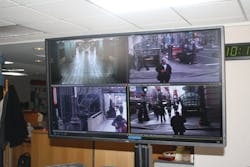When an incident occurs on a form of mass transit, it can lead some people to try and become opportunistic to the opportunity presented to them.
And transit officers investigating an incident can find plenty of instances where someone is trying to take advantage of a situation, but investigators with the Southeastern Pennsylvania Transportation Authority are taking steps to curb fraudulent claims and solve crimes with cameras.
“Sometimes it’s very easy,” Jim Jordan, general counsel for SEPTA said. “When there’s a crime, the police can get the video immediately and when there’s a serious accident, we’ll have investigators at the scene, but for the more routine events, we have to be trying to capture as much as we can because it’s already starting to pay off in very significant terms.”
Several years ago, SEPTA started placing surveillance cameras on buses and in stations to begin building an extensive network cameras providing real time information to the agency’s control center. The agency is continuing to add cameras to buses to make sure all buses and other SEPTA vehicles are equipped with cameras.
“As of today, we have 15,000 cameras in our system and by 2015, we’ll have 24,000 cameras,” Jordan said. “And all of them will work.”
While there are some instances of cameras catching SEPTA employees being at fault for incidents, Jordan said it has been striking the absolutely fraudulent claims captured during or after an incident. In some cases, the cameras will actually catch some people boarding a bus after it’s involved in an accident, then begin to hold their neck as if they were in pain.
And all the information is being steamed live to SEPTA’s headquarters where investigators pour over hours of video.
“It’s going to be state of the art and a very valuable asset,” Jordan said. “We want to have it to the point where when we do have plaintiff’s and lawyers up here for depositions, we’re going to bring them to their deposition through here.”
Jordan said SEPTA is striving to make the video monitoring a 24/7 operation with up to 16 data analysts, retrieving data and managing the slough of information flowing in constantly. He said SEPTA made the decision to have its camera frames running at relatively low speeds in order to enhance the images captured. However, the higher quality image does mean the system will overwrite images more quickly.
The additions of cameras to the stations have also helped the Philadelphia Police Department solve crimes after perpetrators near the times of the crimes. In one instance, Jordan said a cab driver was robbed, kidnapped and stuffed in a trunk by two men, who had the victim pick them up at a SEPTA station. After reviewing footage, SEPTA was able to get the identities of the culprits who Jordan said were “well known” by the local police.
In another instance, police found a scarf at the scene of a murder and after reaching out to SEPTA investigators, they were able to discover footage of the suspect riding a SEPTA vehicle with the scarf from the scene, followed by later getting on again without the scarf.
SEPTA is continuing to broaden its camera usage, including the purchase of a new mobile unit that is run on solar power and can provide feeds to iPads for use during tactical situations.
“The word is getting out,” Jordan said. “We do have lawyers who will call use before a suit is filed and ask ‘do you have video on this.’”
About the Author
Joe Petrie
Associate Editor
I came to Mass Transit in 2013 after spending seven years on the daily newsbeat in southeastern Wisconsin.
Based in Milwaukee, I worked as a daily newspaper reporter with the Waukesha Freeman from 2006-2011, where I covered education, county and state government. I went on to cover courts for Patch.com, where I was the main courts reporter in the Metro Milwaukee cluster of websites.
I’ve won multiple awards during the course of my career and have covered some of the biggest political events in the past decade and have appeared on national programs.
Having covered local government and social issues, I discovered the importance of transit and the impact it can have on communities when implemented, supported and funded.

